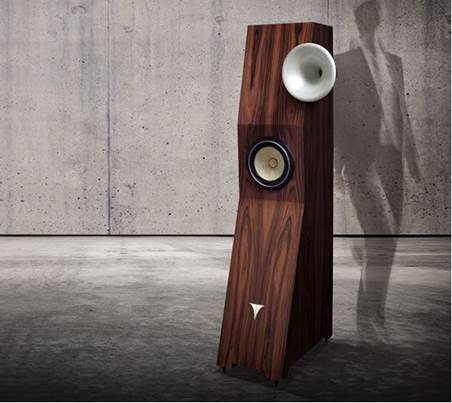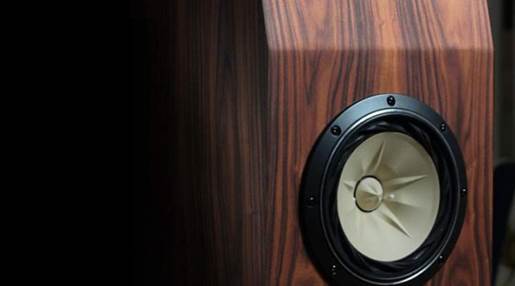This sensitive speaker with its
adjustable tractrix horn could see grins all round, provided you have the space
for it…
If you want a hi-fi system to create some
semblance of lifelike scale and dynamics when playing recordings of a favorite
band live in concert, or a symphony orchestra in full flight, it makes sense to
apportion a large part of loudspeakers you can sensibly accommodate. For the
biggest bang for your buck add a modest amplifier and source and you’ll be
grinning like a Cheshire cat – especially if it’s image size that matters to
you most.
This Marvel model from Greek manufacturer
TuneAudio is a very large floorstander for the money. Admittedly it has only a
simple driver complement – a solitary 200mm (8in) bass/mid driver coupled with
a horn-loaded high frequency compression driver but it boasts an imposing
enclosure standing 1.5m tall. And while it’s perhaps not quite as sensitive as
TuneAudio suggests in its literature, any speaker with a sensitivity above
90dB/1W/1m is going to generate more than adequate sound pressure levels when
fed a mere handful of watts.

This
Marvel model from Greek manufacturer TuneAudio is a very large floorstander for
the money.
Jack Durant of DB Audio in Worcestershire,
who imports TuneAudio’s horn loudspeaker range, is a fan (and re-seller) of
Ming Da Chinese-made value amplifiers, so I asked him to supply a modest
integrated model to mate with the Marvels. I was afraid my 100W solid-state
Levinson amplifier might not be an ideal partner for a pair of very sensitive
horns – although it transpired I needn’t have worried. He arranged a loan of
Ming Da’s entry-level MC368-B902 model, an 18W Class A integrated employing two
KT90 beam pentodes running single-ended.
With my Mac mini and Dell touch-screen as a
source, this made for a complete audio system costing less than $16,500: a mere
bagatelle in today’s world of high-end audio. It turned out to be considerably
more than the sum of its parts, capable of effortlessly loading my large
listening room with images of musicians of convincing scale and substance.
As with all TuneAudio’s loudspeaker
designs, the Marvel’s cabinet is hand-crafted using Balttic birch plywood,
finished in real wood veneers or painted and lacquered to customers’ individual
requirements. Our review pair sported satin-finished walnut veneers, perfectly
matched speaker to speaker. Clearly, TuneAudio takes considerable pride in its
craftsmanship. The fine attention to detail extends to the hard-wired
first-order crossovers and internal cabling of OFC wire, which is constructed
in-house in true artisan fashion, the wire covered with cotton fabric and
coated in beeswax. The Marvel’s highly polished brass rear panel with its hefty
binding posts and the adjustable spiked feet also appear beautifully made and
finished.
Outrigger horn assembly
The high frequency unit employed in the
Marvel is a DE200 compression driver made by Italian company B&C Speakers (www.bcspeakers.com) which specializes in
drivers for professional audio and sound reinforcement applications, it boasts
a titanium diaphragm with a 25mm (1in) throat diameter, 44mm (1.7in) aluminum
voice coil and ceramic magnet. The DE200, which TuneAudio says it modifies for its
specific application, fires into a tractrix horn made in-house using a
proprietary combination of aggregates and epoxy resin. The HF horn assembly
bolts onto the side of the main enclosure via a mounting plate of polished
brass with felt decoupling.
Frequencies below 2500Hz are handled by a
modified Fostex FE208EZ from its FE-E Sigma Series of drivers, with a
‘hyperbolic paraboloid profile’ cone (made from banana plant fiber) and a
tangential edge/damper. Midrange frequencies are radiated directly by the cone,
while the driver is back-loaded by the Marvel’s downward-firing, flared but
prematurely terminated bass ‘horn’ enclosure.

A
200mm driver is back-loaded by the Marvel’s downward-firing exponential ‘horn’
enclosure. The HF compression unit with tractrix horn can be adjusted to angle
its beam
Says TuneAudio: ‘the bass is an exponential
horn tuned to 50Hz using the floor as a virtual expansion of the missing
length/mouth’. Indeed, as well as tuning-in the Marvel’s sound to your room by
positioning the HF horn to fiber at your hot seat, subtly altering the height
of the speaker using the adjustable spikes plays a crucial role in fine-tuning
the subjective bass performance. A hard reflective surface beneath the speaker
is required. As I have thick fitted carpets, the Marvels were sited on
inexpensive slabs of granite, of the type commonly used for kitchen
chopping-boards.
Fast and explicit
Although these substantial floor standers
require room to breathe – TuneAudio recommends that you sit at least 2m away
from the Marvels and that they should be spaced at least 1.5m apart – they do
need some boundary wall reinforcement to ‘flesh out’ their sound. Once I’d
positioned them close (0.5m) to the corners of my room and carefully adjusted
the alignment of the high frequency horns to fire at my listening seat I was
greeted with an impressively vivid and well-defined sound with a tremendous
ability to drag me into the music.
Playing the album… All This Time, a 2001
live recording of Sting in a fairly intimate stage-setting, the Marvels’ vivid
depiction of instruments’ leading-edge transients and dynamic shadings helped
create a wonderful sense of occasion. In spite of my earlier fears, there was
no ‘sonic mismatch’ with my resident Mark Levinson No.383 amplifier, the
speakers’ fast and explicit temperament harmonizing most successfully with the
amp’s soft sensuality, characterized by its luscious, creamy mid band-bass
accompaniment of Christian McBride was tight and well-articulated, if slightly
pinched and with a ‘quacky’ coloration in the upper bass – something that could
also be heard in the sound of Manu Katche’s drums. The Marvels don’t go really
low, but they deliver fast and clearly-expressed bass devoid of stodgy ‘tails’,
which naturally enhances the overall impression of clarity and transient speed.

The
speakers sounded even more agile and ‘alive’ when driven by the little Ming Da
MC368-B902 integrated
Listeners who are concerned with tonal
accuracy will surely call into question these loudspeakers’ hi-fi credentials
as there’s no denying they do sound colored. If you’re unable to mentally dial
out that Quacky bass quality you’ll find them impossible to live with. But for
those who can ignore these deficiencies and value the speakers’ speed and
vibrancy, the Marvels’ depiction of musical events is abundant with qualities
that help suspend disbelief while listening.
The speakers sounded even more agile and
‘alive’ when driven by the little Ming Da MC368-B902 integrated. Trading the
Levison’s supers-smooth civility for a tad more openness and sparkle, the sound
of the Marvels in unison with the diminutive tube amp was highly articulate and
expressive. Again, there was no disguising the pinched tonality in the upper
bass as I listened to ‘Liberty’, and the title track, from the 1995 album trust
by bass virtuoso Patrick O’Hearn (Deep Cave Records DCR1001-2). While the
Marvels create a credible sensation of bass weight and punch and you might care
very little when rockin’ out to Led Seppelin or Linkin Park at high SPLs –
their limited transparency and added colorations means they can’t properly
describe textural shading and timbres of low-register instruments, or define
the types of acoustic settings in which such are recorded.
Nevertheless, as I basked in the hypnotic
and ethereal music from Trust the cavernous image created by the Marvels was
undeniably appealing: wide and deep with more than sufficient air to make me
forget the ‘hi-fi’ and wallow in the musical message. O’Hearn’ sonic painting
was projected into the room seemingly effortlessly, his own-label recording’s
artificially fashioned image all-enveloping.
Added to this was the Marvel’s beautifully
relaxed treble quality, which was never brittle, shouty or fatiguing, even at
ear-damagingly high sound pressure levels.